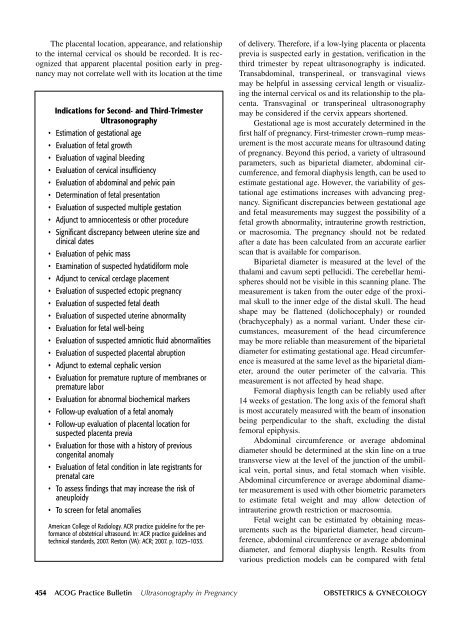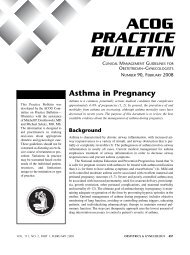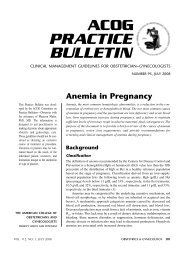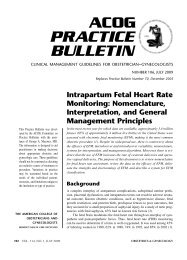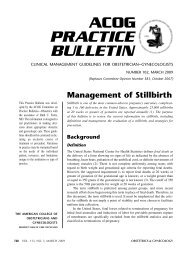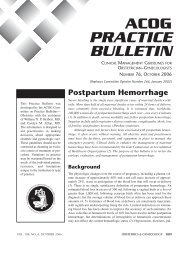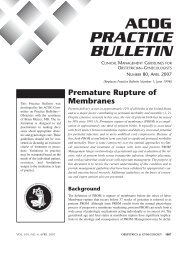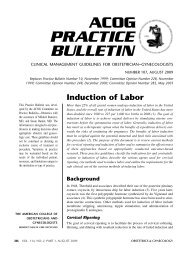ACOG Practice Bulletin No. 101
ACOG Practice Bulletin No. 101
ACOG Practice Bulletin No. 101
Create successful ePaper yourself
Turn your PDF publications into a flip-book with our unique Google optimized e-Paper software.
The placental location, appearance, and relationship<br />
to the internal cervical os should be recorded. It is recognized<br />
that apparent placental position early in pregnancy<br />
may not correlate well with its location at the time<br />
Indications for Second- and Third-Trimester<br />
Ultrasonography<br />
• Estimation of gestational age<br />
• Evaluation of fetal growth<br />
• Evaluation of vaginal bleeding<br />
• Evaluation of cervical insufficiency<br />
• Evaluation of abdominal and pelvic pain<br />
• Determination of fetal presentation<br />
• Evaluation of suspected multiple gestation<br />
• Adjunct to amniocentesis or other procedure<br />
• Significant discrepancy between uterine size and<br />
clinical dates<br />
• Evaluation of pelvic mass<br />
• Examination of suspected hydatidiform mole<br />
• Adjunct to cervical cerclage placement<br />
• Evaluation of suspected ectopic pregnancy<br />
• Evaluation of suspected fetal death<br />
• Evaluation of suspected uterine abnormality<br />
• Evaluation for fetal well-being<br />
• Evaluation of suspected amniotic fluid abnormalities<br />
• Evaluation of suspected placental abruption<br />
• Adjunct to external cephalic version<br />
• Evaluation for premature rupture of membranes or<br />
premature labor<br />
• Evaluation for abnormal biochemical markers<br />
• Follow-up evaluation of a fetal anomaly<br />
• Follow-up evaluation of placental location for<br />
suspected placenta previa<br />
• Evaluation for those with a history of previous<br />
congenital anomaly<br />
• Evaluation of fetal condition in late registrants for<br />
prenatal care<br />
• To assess findings that may increase the risk of<br />
aneuploidy<br />
• To screen for fetal anomalies<br />
American College of Radiology. ACR practice guideline for the performance<br />
of obstetrical ultrasound. In: ACR practice guidelines and<br />
technical standards, 2007. Reston (VA): ACR; 2007. p. 1025–1033.<br />
of delivery. Therefore, if a low-lying placenta or placenta<br />
previa is suspected early in gestation, verification in the<br />
third trimester by repeat ultrasonography is indicated.<br />
Transabdominal, transperineal, or transvaginal views<br />
may be helpful in assessing cervical length or visualizing<br />
the internal cervical os and its relationship to the placenta.<br />
Transvaginal or transperineal ultrasonography<br />
may be considered if the cervix appears shortened.<br />
Gestational age is most accurately determined in the<br />
first half of pregnancy. First-trimester crown–rump measurement<br />
is the most accurate means for ultrasound dating<br />
of pregnancy. Beyond this period, a variety of ultrasound<br />
parameters, such as biparietal diameter, abdominal circumference,<br />
and femoral diaphysis length, can be used to<br />
estimate gestational age. However, the variability of gestational<br />
age estimations increases with advancing pregnancy.<br />
Significant discrepancies between gestational age<br />
and fetal measurements may suggest the possibility of a<br />
fetal growth abnormality, intrauterine growth restriction,<br />
or macrosomia. The pregnancy should not be redated<br />
after a date has been calculated from an accurate earlier<br />
scan that is available for comparison.<br />
Biparietal diameter is measured at the level of the<br />
thalami and cavum septi pellucidi. The cerebellar hemispheres<br />
should not be visible in this scanning plane. The<br />
measurement is taken from the outer edge of the proximal<br />
skull to the inner edge of the distal skull. The head<br />
shape may be flattened (dolichocephaly) or rounded<br />
(brachycephaly) as a normal variant. Under these circumstances,<br />
measurement of the head circumference<br />
may be more reliable than measurement of the biparietal<br />
diameter for estimating gestational age. Head circumference<br />
is measured at the same level as the biparietal diameter,<br />
around the outer perimeter of the calvaria. This<br />
measurement is not affected by head shape.<br />
Femoral diaphysis length can be reliably used after<br />
14 weeks of gestation. The long axis of the femoral shaft<br />
is most accurately measured with the beam of insonation<br />
being perpendicular to the shaft, excluding the distal<br />
femoral epiphysis.<br />
Abdominal circumference or average abdominal<br />
diameter should be determined at the skin line on a true<br />
transverse view at the level of the junction of the umbilical<br />
vein, portal sinus, and fetal stomach when visible.<br />
Abdominal circumference or average abdominal diameter<br />
measurement is used with other biometric parameters<br />
to estimate fetal weight and may allow detection of<br />
intrauterine growth restriction or macrosomia.<br />
Fetal weight can be estimated by obtaining measurements<br />
such as the biparietal diameter, head circumference,<br />
abdominal circumference or average abdominal<br />
diameter, and femoral diaphysis length. Results from<br />
various prediction models can be compared with fetal<br />
454 <strong>ACOG</strong> <strong>Practice</strong> <strong>Bulletin</strong> Ultrasonography in Pregnancy OBSTETRICS & GYNECOLOGY


